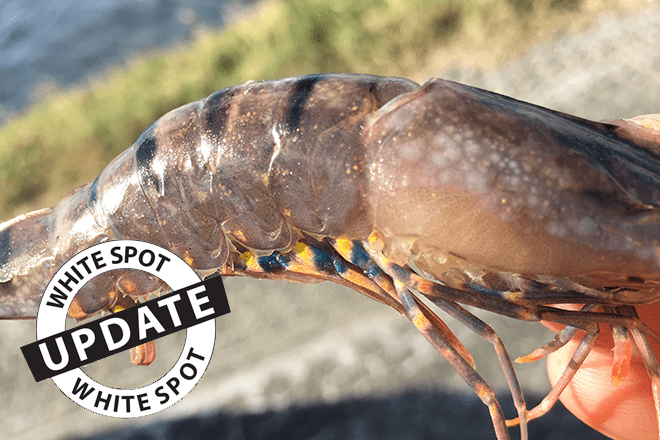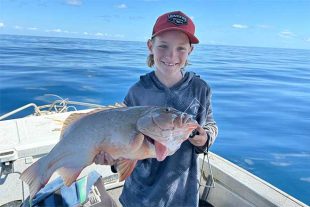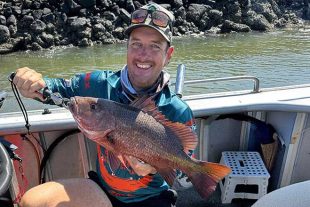THE latest round of surveillance tests conducted by Biosecurity Queensland show no signs of white spot disease in southeast Queensland waters, more than two-and-a-half years after the virus devastated the big prawn farms on the Logan River.
It’s a big relief for the prawn farmers whose stocks were destroyed after white spot disease was first discovered two-and-a-half years ago, and who have restocked their production ponds again. Prawn and marine worm samples were taken from a number of locations within Moreton Bay, Logan and Brisbane rivers and all returned negative results. Minister for Agricultural Industry Development and Fisheries Mark Furner said it was great news for the industry and its employment prospects.
“This is the second consecutive surveillance round conducted by my department which has returned negative results for the virus that causes white spot disease,” Mr Furner said. “If another round of tests next year is negative Queensland and Australia would be declared free of white spot disease. But this means everyone must continue to remain vigilant to ensure the disease is contained and does not spread. I thank the industry for its resilience and patience during this hard time, and the general community, especially recreational fishers for heeding our messages and helping stop the spread of the disease.”
Australian Prawn Farmers Association President Matt West said all his members have their fingers crossed hoping the white spot outbreak is over.
“Affected businesses have gone through a lot of financial and mental stress with our Logan farms having to shut down for lengthy periods with the sole purpose of eradicating the disease,” Mr West said. “Everyone has done an amazing job, but we’ve had a wake-up call to remain vigilant, not just for white spot but other diseases coming into the country. It’s imperative we boost exotic disease testing regimes at our borders to prevent any other major disease outbreaks. An end to the white spot disease outbreak would be very good result indeed, not only for the Logan farmers but Queensland’s prawn farming industry, which is currently enjoying a considerable, state-wide, expansionary phase. Established aquaculture companies and major new entrants are spending millions and millions of dollars expanding their farms or constructing some new large-scale operations. There’s such unlimited demand for our prawns. Seafood suppliers take everything we can produce.”
White spot disease is a highly contagious viral infection that affects crustaceans, prawns and crabs, but it is not harmful to human health and these seafoods are safe to eat. Additional biosecurity measures are in place on the Logan prawn farms where white spot disease was first detected to protect the farms from disease incursions. Line fishing is still not permitted around the prawn farm inlet and outlet channels and this measure will remain enforced at this time. So will movement restrictions for raw prawns, yabbies and marine worms in southeast Queensland.
Three of seven Logan farms and their prawn farmers restocked their ponds last summer and the biggest operator harvested around 421 tonnes of their much sought-after prawns. Although well down on prior to the disease outbreak, production is set to double again later this year. The battling Logan prawn farmers got another much-needed boost after the owners of Gold Coast Marine Aquaculture won the prestigious Champion Prawn and the Champion Aquaculture Product Trophy at the Sydney Royal Show, which sets the quality bench mark for all Australian seafood.
Noel Herbst pioneered prawn farming in Queensland establishing his family-run business on the Logan in 1986. Debbie Herbst said the achievement was extra sweet.
“Especially coming in our first year back in production,” she said. “Winning awards like that makes us feel proud of what we produce.”
Mr Furner said the global aquaculture industry was valued in the hundreds of billions of dollars and Queensland was well placed to take advantage of the opportunities on offer.
“Overseas, aquaculture is rapidly overtaking the wild caught fishery in value,” Mr Furner said. “In Queensland the industry is valued at over $120 million and rising fast, with the production of prawns making up the lion’s share of this figure. To boost the sector further, the Government has identified six Aquaculture Development Areas in the Townsville, Whitsunday, Mackay, Rockhampton and Gladstone regions. Identifying areas suitable for aquaculture development is an important initiative to grow the industry and will bring more jobs in a stronger regional Queensland economy. My Department reports there has already been a number of enquiries from prospective entrants.”
Mr Furner said the Ask for Queensland Seafood campaign featuring footy legend Sam Thaiday helped to restore confidence for seafood lovers buying Queensland seafood. “Nothing beats Queensland’s fresh, tasty and delicious seafood,” he said. Mr Furner recently launched the #eatqld campaign asking Queenslanders to buy great-tasting Queensland produce.
“Buying local produce benefits local businesses, it creates more jobs, commercial fishers continue to support their families and Queenslanders can enjoy fresh seafood,” Mr Furner said.
 Bush ‘n Beach Fishing Magazine Location reports & tips for fishing, boating, camping, kayaking, 4WDing in Queensland and Northern NSW
Bush ‘n Beach Fishing Magazine Location reports & tips for fishing, boating, camping, kayaking, 4WDing in Queensland and Northern NSW









